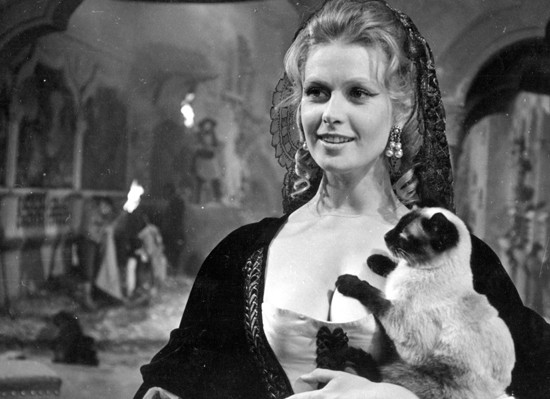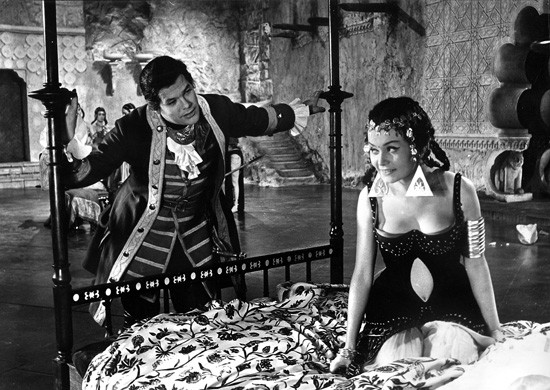The National Gallery of Art’s film program provides many opportunities throughout the year to view classic and contemporary cinema from around the world.
View the current schedule here.
Download the Spring 2016 Film Calendar (PDF 306KB)
still from How to Be Loved, courtesy Filmoteka Narodowa, Warsaw
A Film Found in Saragossa
Released two years after the premiere of How to Be Loved, the film that followed—The Saragossa Manuscript—emanated an entirely different character, bearing testimony to the director’s versatility. Against the background of Has’s previous films, psychological dramas set in rather intimate environments, The Saragossa Manuscript marked a major shift with regard to themes and imagery.[1] Based on a novel by Jan Potocki (1761–1815), the film is a period drama set in the mountains and towns of eighteenth-century Spain. The pursuit of an entirely new genre allowed Has to demonstrate his individual style as a filmmaker, a style that transcended the boundaries of genres and epochs.[2] For, as we will see, The Saragossa Manuscript bears more kinship to other films by Has than it might appear on the surface.
The Saragossa Manuscript is also an adaptation, however different the choice of the original literary work compared to Jak być kochaną, an intimate short story by Kazimierz Brandys on which How to Be Loved was based, and other literary pieces that Has transferred onto the movie screen. Written at the turn of the nineteenth century, Potocki’s magnum opus is a philosophical novel that spans an extensive network of protagonists and narratives. It was the complex literary structure and the mysterious aura with a heavy oneiric load that attracted Has to Potocki’s book. Another factor was the universal message conveyed both through the protagonists’ adventures and multiple layers of various cultural and philosophical references. A complex treatise on the seminal questions of its era—the Enlightenment—Has considered the book to be a universal story of humanity.[3] To fit Potocki’s novel within a cinematic format, it was necessary to select the most important stories from more than thirty included in the book. Following its literary source, Has’s film revolves around uncanny attempts made by the Gomelez family to convert a young captain of the Walloon Guards, Alfons van Worden, to Islam. His journey, an initiation that affords a cognitive insight into the complexity of the world, is at the core of the film.

still from The Saragossa Manuscript, courtesy Filmoteka Narodowa, Warsaw
The Saragossa Manuscript came as yet another opportunity for Has to demonstrate his unique approach to basing films on literature. Working with the screenwriter Tadeusz Kwiatkowski, the director sought to provide a visual equivalent of the novel’s structure, marked by its omnipresent mise en abyme, and to convey its complexity through imagery heavily saturated with meanings. Hence, the preparations for the film’s production involved a lengthy process of creating Has’s signature comprehensive and extremely detailed shooting script.
Characteristically, upon adapting Potocki’s novel, Has created a cinematic reality that does not break ties with the original work, but remains idiosyncratic enough to stand firmly as a distinct artistic phenomenon, an expression of his cinematic style based on a range of overarching principles that the realities of his films follow. As we have already noted, these principles include time’s all-encompassing and prominent role in shaping the realm of the film. In The Saragossa Manuscript, the powerful nature of Has’s cinematic time manifests itself through never-ending twists, turns, and repetitions that constantly bring the protagonist to the same point. Marcin Maron views Has’s approach to time as an ironic game played with the main character, which consists of reducing time to an eternal, recurrent “now.”[4]
Clearly, and again characteristically for Has, the filmic reality is shaped by time as experienced by an individual and is therefore extremely subjective, heavily influenced by the work of memory, prone to delusions and mysterious inconsistencies; it is time as experienced in the realm of dreams. The multitude of narrators also contributes to the complexity of time in both the novel and the film adaptation of The Saragossa Manuscript.[5] Each storyteller introduces a new temporal order resulting from his or her subjective experience of time. Yet, as was the case in How to Be Loved, The Saragossa Manuscript develops another level of time that determines its cinematic reality. Maron regards the film as a turning point in terms of Has’s portraiture of time, a film where the “scale and scope of the experience of time depicted by Has becomes complicated” because of the cultural and philosophical layer embedded in the temporal experience.[6]
In The Saragossa Manuscript, time once again demonstrates its prominent status as the underlying factor of the film’s reality. Akin to How to Be Loved, where the nature of the setting results directly from the temporal order in which a given scene is situated, in The Saragossa Manuscript, the setting remains sensitive to time and changes accordingly. It also resonates with the developments and mental states of the protagonists, serving not as a mere frame or background but as a non-human participant, one that symbiotically relates to the film’s characters. A good example of such changes can be observed in the scenes set in the underground cave accessed from the deserted inn Venta Quemada. The scholar Iwona Gródź highlights the transformation that the underground scenery undergoes within a short, one-day timespan. When Alfons van Worden first encounters the two princesses, the cave is portrayed as a brightly lit, exuberant underground hall. But when he returns just the next day, the setting is altogether different: the place is plunged in murk, skulls and bones lie scattered on the floor, spider webs cover the walls.[7]

still from The Saragossa Manuscript, courtesy Filmoteka Narodowa, Warsaw
The lively and elaborate sceneries in The Saragossa Manuscript not only actively resonate with the temporal and mental shifts experienced by the protagonist of the film, but also convey a wealth of symbolic, cultural, and philosophical references. A venue that is particularly saturated with such meanings is the castle of Don Pedro Uzeda, the Cabalist. This space reveals an abundance of references to Cabala, astrology, geometry, chiromancy, and magic.[8] Conveyed mostly through the images on the walls and artifacts gathered in the interiors of the castle, these symbols serve to underscore the different philosophical mind-sets represented by the Cabalist’s guests.[9] On a more general level, the aesthetic realm of the film becomes a platform to convey the vast philosophic and Cabalist layers of Jan Potocki’s novel, which could not be explicitly stated in the film due to the limitations of the cinematic format.[10]
The world of The Saragossa Manuscript abounds in mysterious and magical occurrences. The characters in the film inhabit a reality penetrated by demons. Spirits of the dead haunt the living, while mysterious landscapes are strewn with human skulls and bones. Otherworldly phenomena are aplenty. For instance, there seems little logic behind Alfons van Worden’s instant passage from the deserted inn to the underground hall inhabited by the two princesses. Equally unexplained are the circumstances in which the protagonist's father encounters his future wife. Carried by his servants through a barren, rocky landscape after a duel, Alfons’s father longs for a sip of water. Suddenly, a woman from the Gomelez family emerges from behind a rock with a jug of water to share with the wounded man. This mysterious encounter is soon followed by their wedding. It is easy to notice that the entire supernatural dimension of the film often gravitates toward humour. Mystery comes close to comedy. Fear and violence are mocked and demons are often more hilarious than scary, a fact that significantly disturbs the genre classification of the film.[11] Yet, perfectly balanced, this dose of humour does not deprive The Saragossa Manuscript of its philosophical gravitas. The same applies to its kinship with swashbuckler films, a genre that Has emulates and mocks at the same time. The director avoids entrapment in the confines of a single genre and builds a many-sided, unobvious cinematic structure that bridges a variety of traditions.
[1] It was also markedly different from the film that followed, Codes (Szyfry). Iwona Gródź, Zaszyfrowane w obrazie: o filmach Wojciecha Jerzego Hasa (Gdańsk: Słowo/Obraz Terytoria, 2008), 208. (back to top)
[2] Gródź, Zaszyfrowane w obrazie, 201. (back to top)
[3] Ibid., 209. (back to top)
[4] Maron, Dramat czasu I wyobraźni, 86. (back to top)
[5] Gródź, Zaszyfrowane w obrazie, 247. (back to top)
[6] Maron, Dramat czasu I wyobraźni, 84. (back to top)
[7] Gródź, Zaszyfrowane w obrazie, 259. (back to top)
[8] Ibid., 233. (back to top)
[9] For instance, the intuitive approach of Don Pedro Uzeda is conveyed through an array of allusions to the iconography of Cabala, astrology, freemasonry, tarot, etc., whereas Velazquez’s rationalism is portrayed through geometrical schemes visible in the background. Ibid., 233. (back to top)
[10] Ibid., 234. (back to top)
[11] Ibid., 258. (back to top)
